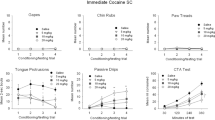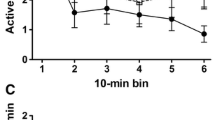Abstract
In a conditioned taste-aversion experiment with male Wistar rats (two-bottle test, single pairing), the effects of β-phenylethylamine (PEA 12.5, 25.0, 50.0, 100.0 mg/kg IP) and of d-amphetamine (2.5 mg/kg IP) were compared with the effect of the saline vehicle. The amphetamine-treated group exhibited a marked aversion to saccharin on each of four retention trials. A decrease in saccharin intake after PEA was limited to the highest dose group (100 mg/kg) and the first retention trial for that group. Doses of up to 50 mg/kg of PEA were also ineffective with a single-bottle conditioned taste-aversion procedure involving multiple conditioning trials, although doses of 25 and 50 mg/kg of PEA induced marked changes in spontaneous motor activity. These data demonstrate that behaviourally active doses of PEA are ineffective in inducing a conditioned taste aversion to saccharin. This result extends previous reports that structurally similar compounds may have different potencies in this paradigm. It is proposed that further studies of structureactivity relationships may help to reveal the features of drug action that are necessary for the induction of a conditioned taste aversion.
Similar content being viewed by others
References
Barker LM, Smith JC, Suarez EM (1977) “Sickness” and the backward conditioning of taste aversions. In: Barker LM, Best MR, Domjan M (eds) Learning mechanisms in food selection. Baylor University Press, Waco, Texas, pp 533–553
Berger BD (1972) Conditioning of food aversions by injections of psychoactive drugs. J Comp Physiol Psychol 81:21–26
Booth DA, Pilcher CWT, D'Mello GD, Stolerman IP (1977) Comparative potencies of amphetamine, fenfluramine and related compounds in taste aversion experiments in rats. Br J Pharmacol 61:664–677
Davis WM, Bedford JA, Buelke JL, Guinn MM, Hatoum HT, Waters IW, Wilson MC, Braude MC (1978) Acute toxicity and gross behavioural effects of amphetamine, four methoxyamphetamines and mescaline in rodents, dogs and monkeys. Toxicol Appl Pharmacol 45:49–62
D'Mello GD, Goldberg DM, Goldberg SR, Stolerman IP (1981) Conditioned taste aversion and operant behaviour in rats: effects of cocaine, apomorphine and some long-acting derivatives. J Pharmacol Exp Ther 219:60–67
Dourish CT (1981) Behavioural effects of acute and chronic β-phenylethylamine administration in the rat: evidence for the involvement of 5-hydroxytryptamine. Neuropharmacology 20:1067–1072
Dourish CT, Boulton AA (1981) The effects of acute and chronic administration of β-phenylethylamine on food intake and body weight in rats. Prog Neuropsychopharmacol 4:411–414
Dourish CT, Cooper SJ (1981) Effects of acute or chronic administration of low doses of a dopamine agonist on drinking and locomotor activity in the rat. Psychopharmacology 72:197–202
Dourish CT, Greenshaw AJ, Boulton AA (1983) Deuterium substitution enhances the effects of β-phenylethylamine on spontaneous motor activity in the rat. Pharmacol Biochem Behav 19:471–475
Durden DA, Philips SR, Boulton AA (1973) Identification and distribution of β-phenylethylamine in the rat. Can J Biochem 51:995–1002
Foltin RW, Schuster CR (1982) The effects of cocaine in a gustatory avoidance paradigm: a procedural analysis. Pharmacol Biochem Behav 16:347–352
Fuxe K, Grobecker H, Jonsson J (1967) The effects of β-phenylethylamine on central and peripheral monoamine containing neurons. Eur J Pharmacol 2:202–207
Goudi AJ (1979) Aversive stimulus properties of drugs. Neuropharmacology 19:971–979
Goudie AJ (1982) Discriminative stimulus properties in an operant task of β-phenylethylamine. In: Colpaert FC, Slangen JL (eds) Drug discrimination: applications in CNS pharmacology. Janssen Research Foundation, Elsevier Biomedical Press, Amsterdam, pp 165–180
Goudie AJ, Dickins DW (1978) Nitrous oxide induced conditioned taste aversion in rats: the duration of drug exposure and its relation to the taste aversion/self administration paradox. Pharmacol Biochem Behav 9:587–592
Goudie AJ, Dickins DW, Thornton EW (1978) Cocaine-induced taste aversions in rats. Pharmacol Biochem Behav 8:757–761
Greenshaw AJ, Dourish CT (1983) β-Phenylethylamine and d-amphetamine: differential potency in the conditioned taste aversion paradigm. In: Boulton AA, Sandler M, Dewhurst WG, Baker GB (eds) Trace amines and the neurosciences. Humana Press, New Jersey (in press)
Huang JT, Ho BT (1974) The effect of pretreatment with iproniazid on the behavioural activities of β-phenylethylamine in rats. Psychopharmacology 35:77–81
Ionescu E, Bures ová O (1977) Failure to elicit conditioned taste aversion by severe poisoning. Pharmacol Biochem Behav 6:251–254
Moore KE, Chieuh CC, Zelds G (1977) Release of neurotransmitters from the brain in vivo by amphetamine methylphenidate and cocaine. In: Ellinwood Jr EH, Kilby MM (eds) Cocaine and other stimulants. Plenum Press, New York, pp 143–160
Nachman M, Hartley PL (1975) Role of illness in producing learned taste aversions in rats. A comparison of several rodenticides. J Comp Physiol Psychol 87:622–643
Randrup A, Munkvad I (1967) Stereotyped activity produced by amphetamine in several animal species and man. Psychopharmacology 11:300–310
Sabelli HC, Vazquez AJ, Flavin D (1975) Behavioral and electrophysiological effects of phenylethanolamine and 2-phenylethylamine. Psychopharmacologia 42:117–125
Sanger DJ, Greenshaw AJ, Thompson IP, Mercer JD (1980) Learned taste aversion to saccharin produced by orally consumed d-amphetamine. Pharmacol Biochem Behav 13:31–36
Shannon HE, DeGregorio CM (1982) Self administration of the endogenous trace amines β-phenylethylamine, N-methyl-phenylethylamine and phenylethanolamine in dogs. J Pharmacol Exp Ther 222:52–60
Stein L (1964) Self-stimulation of the brain and the central stimulant action of amphetamine. Fed Proc 23:836–850
Switzman L, Hunt T, Amit Z (1981) Heroin and morphine: aversive and analgesic effects in rats. Pharmacol Biochem Behav 15:755–759
Wu PH, Boulton AA (1975) Metabolism, distribution and disappearance of injected β-phenylethylamine in the rat. Can J Biochem 53:42–50
Author information
Authors and Affiliations
Rights and permissions
About this article
Cite this article
Greenshaw, A.J., Dourish, C.T. Differential aversive stimulus properties of β-phenylethylamine and of d-amphetamine. Psychopharmacology 82, 189–193 (1984). https://doi.org/10.1007/BF00427771
Received:
Accepted:
Issue Date:
DOI: https://doi.org/10.1007/BF00427771




